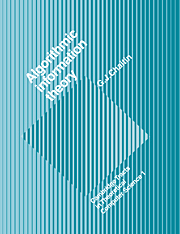Book contents
- Frontmatter
- Contents
- Foreword
- Preface
- Figures
- 1 Introduction
- I Formalisms for Computation: Register Machines, Exponential Diophantine Equations, & Pure LISP
- II Program Size, Halting Probabilities, Randomness, & Metamathematics
- 5 Conceptual Development
- 6 Program Size
- 7 Randomness
- 8 Incompleteness
- 9 Conclusion
- A Implementation Notes
- B The Number of S-expressions of Size N
- Bibliography
6 - Program Size
Published online by Cambridge University Press: 23 November 2009
- Frontmatter
- Contents
- Foreword
- Preface
- Figures
- 1 Introduction
- I Formalisms for Computation: Register Machines, Exponential Diophantine Equations, & Pure LISP
- II Program Size, Halting Probabilities, Randomness, & Metamathematics
- 5 Conceptual Development
- 6 Program Size
- 7 Randomness
- 8 Incompleteness
- 9 Conclusion
- A Implementation Notes
- B The Number of S-expressions of Size N
- Bibliography
Summary
Introduction
In this chapter we present a new definition of program-size complexity. H(A, B/C, D) is defined to be the size in bits of the shortest self-delimiting program for calculating strings A and B if one is given a minimal-size self-delimiting program for calculating strings C and D. As is the case in LISP, programs are required to be self-delimiting, but instead of achieving this with balanced parentheses, we merely stipulate that no meaningful program be a prefix of another. Moreover, instead of being given C and D directly, one is given a program for calculating them that is minimal in size. Unlike previous definitions, this one has precisely the formal properties of the entropy concept of information theory.
What train of thought led us to this definition? Following [CHAITIN (1970a)], think of a computer as decoding equipment at the receiving end of a noiseless binary communications channel. Think of its programs as code words, and of the result of the computation as the decoded message. Then it is natural to require that the programs/code words form what is called a “prefix-free set,” so that successive messages sent across the channel (e.g. subroutines) can be separated. Prefix-free sets are well understood; they are governed by the Kraft inequality, which therefore plays an important role in this chapter.
One is thus led to define the relative complexity H(A, B/C, D) of A and B with respect to C and D to be the size of the shortest self-delimiting program for producing A and B from C and D. However, this is still not quite right.
- Type
- Chapter
- Information
- Algorithmic Information Theory , pp. 107 - 127Publisher: Cambridge University PressPrint publication year: 1987

